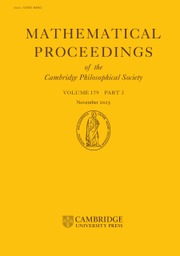No CrossRef data available.
Article contents
A geometric description of the Reidemeister–Turaev torsion for abelian representations on 3-manifolds
Part of:
Low-dimensional topology
Published online by Cambridge University Press: 21 May 2025
Abstract
Let M be a closed oriented 3-manifold equipped with an Euler structure e and an acyclic representation of its fundamental group. We define a twisted self-linking homology class of the diagonal of the two-point configuration space of M with respect to e. This twisted self-linking homology class appears as an obstruction in the Chern–Simons perturbation theory. When the representation is the maximal free abelian representation  $\rho_0$, we prove that our self-linking class is a properly defined “logarithmic derivative” of the Reidemeister–Turaev torsion of
$\rho_0$, we prove that our self-linking class is a properly defined “logarithmic derivative” of the Reidemeister–Turaev torsion of  $(M,\rho_0,e)$ equipped with the given Euler structure.
$(M,\rho_0,e)$ equipped with the given Euler structure.
MSC classification
Information
- Type
- Research Article
- Information
- Mathematical Proceedings of the Cambridge Philosophical Society , Volume 179 , Issue 2 , September 2025 , pp. 233 - 258
- Copyright
- © The Author(s), 2025. Published by Cambridge University Press on behalf of Cambridge Philosophical Society
References
Axelrod, S. and Singer, I. M.. Chern–Simons perturbation theory. In Proceedings of the XXth International Conference on Differential Geometric Methods in Theoretical Physics, vol. 1, 2 (New York, 1991) (World Sci. Publ., River Edge, NJ, 1992).10.1142/9789814538206CrossRefGoogle Scholar
Bott, R. and Cattaneo, A. S.. Integral invariants of 3-manifolds. J. Differential Geom. 48(1)(1998), 91–133.10.4310/jdg/1214460608CrossRefGoogle Scholar
Bott, R. and Cattaneo, A. S.. Integral invariants of 3-manifolds, II. J. Differential Geom. 53(1) (1999), 1–13.10.4310/jdg/1214425446CrossRefGoogle Scholar
Cattaneo, A. S. and Shimizu, T.. A note on the Θ-invariant of 3-manifolds. Quantum Topology. 12(1) (2021).CrossRefGoogle Scholar
Deloup, F. and Massuyeau, G.. Reidemeister–Turaev torsion modulo one of rational homology three-spheres. Geom. Topol. 7(2003), 773–787 (electronic).10.2140/gt.2003.7.773CrossRefGoogle Scholar
Fukaya, K.. Morse homotopy and Chern–Simons perturbation theory. Comm. Math. Phys. 181(1) (1996), 37–90.10.1007/BF02101673CrossRefGoogle Scholar
Goda, H.. Matsuda, H. and Pajitnov, A.. Morse-Novikov theory, Heegaard splittings, and closed orbits of gradient flows. St. Petersburg. Math. J. 26(3) (2015).10.1090/S1061-0022-2015-01345-9CrossRefGoogle Scholar
Goda, H. and Pajitnov, A. V.. Dynamics of gradient flows in the half-transversal Morse theory. Proc. Japan Acad. Ser. A Math. Sci. 85(1) (2009), 6–10.10.3792/pjaa.85.6CrossRefGoogle Scholar
Hutchings, M.. Reidemeister torsion in generalized Morse theory. Forum Math. 14 (2002), 209–244.10.1515/form.2002.010CrossRefGoogle Scholar
Hutchings, M. and Lee, Y. J.. Circle-valued Morse theory, Reidemeister torsion, and Seiberg–Witten invariants of 3–manifolds. Topology 38 (1999), 861–888.10.1016/S0040-9383(98)00044-5CrossRefGoogle Scholar
Hutchings, M. and Lee, Y. J.. Circle-valued Morse theory and Reidemeister torsion. Geom. Topol. 3 (1999), 369–399.10.2140/gt.1999.3.369CrossRefGoogle Scholar
Kitayama, T.. Non-commutative Reidemeister torsion and Morse–Novikov theory. Proc. Amer. Math. Soc. 138 (2010), 3345–3360.Google Scholar
Kontsevich, M.. Feynman diagrams and low-dimensional topology. In First European Congress of Mathematics, vol. II (Paris, 1992). Progr. Math. 120 (Birkhäuser, Basel, 1994), pages 97–121.Google Scholar
Kuperberg, G. and Thurston, D. P.. Perturbative 3-manifold invariants by cut-and-paste topology. ArXiv:math/9912167v2 (1999).Google Scholar
Lescop, C.. A formula for the Theta invariant from Heegaard diagrams. Geom. Topol. 19 (2015), 1205–1248.10.2140/gt.2015.19.1205CrossRefGoogle Scholar
Lescop, C.. On the cube of the equivariant linking pairing for knots and 3–manifolds of rank one. ArXiv:1008.5026 (2010).Google Scholar
Shimizu, T.. An invariant of rational homology 3-spheres via vector fields. Algebr. Geom. Topol. 16(6) (2016), 3073–3101.10.2140/agt.2016.16.3073CrossRefGoogle Scholar
Shimizu, T.. Morse homotopy for the SU(2)-Chern–Simons perturbation theory. J. Differential Geom. 123(2) (2023), pp.363–390.10.4310/jdg/1680883580CrossRefGoogle Scholar
Turaev, V.. Euler structures, nonsingular vector fields, and torsions of Reidemeister-type. Math. USSR–Izv. 34, (1990), 627–662.10.1070/IM1990v034n03ABEH000676CrossRefGoogle Scholar
Turaev, V.. Torsions of 3-dimensional manifolds. Progr. Math. 208, (Birkhäuser Verlag, Basel, 2002).10.1007/978-3-0348-7999-6CrossRefGoogle Scholar
Turaev, V.. Introduction to Combinatorial Torsions, Notes taken by Felix Schlenk, Lectures in Math. ETH Zürich. (Birkhäuser, Basel, 2001).Google Scholar
Watanabe, T.. Higher order generalization of Fukaya’s Morse homotopy invariant of 3-manifolds I. Invariants of homology 3-spheres, Asian J. Math. 22 (1) (2018), 111–180.10.4310/AJM.2018.v22.n1.a4CrossRefGoogle Scholar

